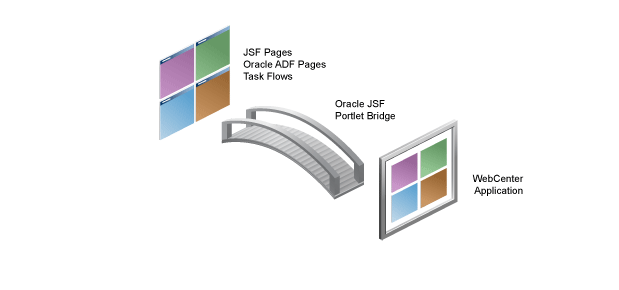
Expose Existing JSF and Oracle ADF Applications and Task Flows
You
can use the Oracle JSF Portlet Bridge (Oracle's implementation of JSR 301)
to turn existing JSF and Oracle ADF applications, portals, and task flows
into standards-based portlets.
For example, suppose your application contains a JSF page that accepts input for Human Resources details such as name, address, nationality, and so on. You can package the page as a WSRP producer and, using the Oracle JSF Portlet Bridge, surface the page as a portlet in your enterprise portal for all your employees.
When you use the Oracle JSF Portlet Bridge, your pages and portlet views become one and the same. Traditionally, developers first build an application, then build portlets to integrate the application with their portal deployment. With Oracle WebCenter Framework and task flows, developers build their application out of a set of task flows that can be individually exposed directly as portlets. In this way, you can build one application that can be delivered as a single portlet or a collection of portlets exposed as a single portlet producer. When changes or updates to this application occur, the portlet is updated immediately. No other development framework provides this revolutionary new technology.
You can customize the pre-built task flows or portlets delivered with WebCenter Services to deliver any specific look and feel that is required. For example, if a user's photo needs to be displayed with each discussion thread, the pre-built task flow can be customized in JDeveloper to add this functionality directly. Traditionally, such modifications would require that developers rebuild applications from scratch if the requirements did not match the pre-built component. Customizations are saved directly into Oracle Metadata Services (MDS) without any coding on your part. This also means that when new versions or patches of the task flows are released, customizations can be directly applied without any complicated merge processes.
For example, suppose your application contains a JSF page that accepts input for Human Resources details such as name, address, nationality, and so on. You can package the page as a WSRP producer and, using the Oracle JSF Portlet Bridge, surface the page as a portlet in your enterprise portal for all your employees.
When you use the Oracle JSF Portlet Bridge, your pages and portlet views become one and the same. Traditionally, developers first build an application, then build portlets to integrate the application with their portal deployment. With Oracle WebCenter Framework and task flows, developers build their application out of a set of task flows that can be individually exposed directly as portlets. In this way, you can build one application that can be delivered as a single portlet or a collection of portlets exposed as a single portlet producer. When changes or updates to this application occur, the portlet is updated immediately. No other development framework provides this revolutionary new technology.
You can customize the pre-built task flows or portlets delivered with WebCenter Services to deliver any specific look and feel that is required. For example, if a user's photo needs to be displayed with each discussion thread, the pre-built task flow can be customized in JDeveloper to add this functionality directly. Traditionally, such modifications would require that developers rebuild applications from scratch if the requirements did not match the pre-built component. Customizations are saved directly into Oracle Metadata Services (MDS) without any coding on your part. This also means that when new versions or patches of the task flows are released, customizations can be directly applied without any complicated merge processes.